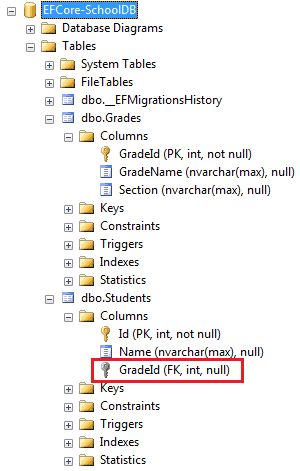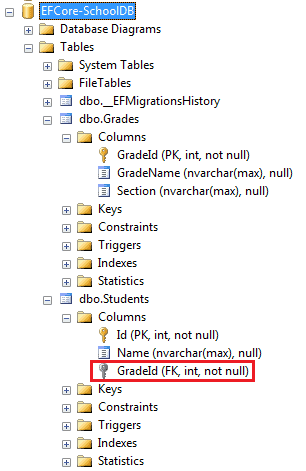One-to-Many Relationship Conventions in Entity Framework Core
In the previous chapter, you learned about the EF conventions which map entities to different objects of the database. Here, you will learn about the relationship conventions between two entity classes that result in one-to-many relationships between corresponding tables in the database.
Entity Framework Core follows the same convention as Entity Framework 6.x conventions for one-to-many relationship. The only difference is that EF Core creates a foreign key column with the same name as navigation property name and not as <NavigationPropertyName>_<PrimaryKeyPropertyName>
Let's look at the different conventions which automatically configure a one-to-many relationship between the following Student and Grade entities.
public class Student { public int StudentId { get; set; } public string StudentName { get; set; } } public class Grade { public int GradeId { get; set; } public string GradeName { get; set; } public string Section { get; set; } }
After applying the conventions for one-to-many relationship in the entities above, the database tables for Student and Grade entities will look like below, where the Students table includes a foreign key GradeId.

Convention 1
We want to establish a one-to-many relationship where many students are associated with one grade.
This can be achieved by including a reference navigation property in the dependent entity as shown below. (here, the Student entity is the dependent entity and the Grade entity is the principal entity).
public class Student { public int Id { get; set; } public string Name { get; set; } public Grade Grade { get; set; } } public class Grade { public int GradeId { get; set; } public string GradeName { get; set; } public string Section { get; set; } }
In the example above, the Student entity class includes a reference navigation property of Grade type. This allows us to link the same Grade to many different Student entities, which creates a one-to-many relation
en them.
This will produce a one-to-many relationship between the Students and Grades tables in the database, where Students table includes a nullable foreign key GradeId, as shown below.
EF Core will create a shadow property for the foreign key named GradeId in the conceptual model, which will be mapped to the GradeId foreign key column in the Students table.

Note: The reference property Grade is nullable, so it creates a nullable ForeignKey GradeId in the Students table. You can configure non null foreign keys using fluent API.
Convention 2
Another convention is to include a collection navigation property in the principal entity as shown below.
public class Student { public int StudentId { get; set; } public string StudentName { get; set; } } public class Grade { public int GradeId { get; set; } public string GradeName { get; set; } public string Section { get; set; } public ICollection<Student> Students { get; set; } }
In the example above, the Grade entity includes a collection navigation property of type ICollection<student>.
This will allow us to add multiple Student entities to a Grade entity, which results in a one-to-many relationship between the Students and Grades tables in the database, just like in convention 1.
Convention 3
Another EF convention for the one-to-many relationship is to include navigation property at both ends, which will also result in a one-to-many relationship (convention 1 + convention 2).
public class Student { public int Id { get; set; } public string Name { get; set; } public Grade Grade { get; set; } } public class Grade { public int GradeID { get; set; } public string GradeName { get; set; } public ICollection<Student> Students { get; set; } }
In the example above, the Student entity includes a reference navigation property of Grade type and the Grade entity class includes a collection navigation property ICollection<Student>, which results in a one-to-many relationship between corresponding database tables Students and Grades, same as in convention 1.
Convention 4
Defining the relationship fully at both ends with the foreign key property in the dependent entity creates a one-to-many relationships.
public class Student { public int Id { get; set; } public string Name { get; set; } public int GradeId { get; set; } public Grade Grade { get; set; } } public class Grade { public int GradeId { get; set; } public string GradeName { get; set; } public ICollection<Student> Students { get; set; } }
In the above example, the Student entity includes a foreign key property GradeId of type int and its reference navigation property Grade.
At the other end, the Grade entity also includes a collection navigation property ICollection<Student>.
This will create a one-to-many relationship with the non null foreign key column in the Students table, as shown below.

If you want to make the foreign key GradeId as nullable, then use nullable int data type (Nullable<int> or int?), as shown below.
public class Student { public int Id { get; set; } public string Name { get; set; } public int? GradeId { get; set; } public Grade Grade { get; set; } }
Therefore, these are the conventions which automatically create a one-to-many relationships in the corresponding database tables. If entities do not follow the above conventions, then you can use Fluent API to configure the one-to-many relationships.